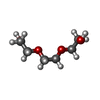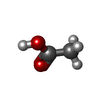+Search query
-Structure paper
| Title | Implications for tetraspanin-enriched microdomain assembly based on structures of CD9 with EWI-F. |
|---|---|
| Journal, issue, pages | Life Sci Alliance, Vol. 3, Issue 11, Year 2020 |
| Publish date | Sep 21, 2020 |
 Authors Authors | Wout Oosterheert / Katerina T Xenaki / Viviana Neviani / Wouter Pos / Sofia Doulkeridou / Jip Manshande / Nicholas M Pearce / Loes Mj Kroon-Batenburg / Martin Lutz / Paul Mp van Bergen En Henegouwen / Piet Gros /  |
| PubMed Abstract | Tetraspanins are eukaryotic membrane proteins that contribute to a variety of signaling processes by organizing partner-receptor molecules in the plasma membrane. How tetraspanins bind and cluster ...Tetraspanins are eukaryotic membrane proteins that contribute to a variety of signaling processes by organizing partner-receptor molecules in the plasma membrane. How tetraspanins bind and cluster partner receptors into tetraspanin-enriched microdomains is unknown. Here, we present crystal structures of the large extracellular loop of CD9 bound to nanobodies 4C8 and 4E8 and, the cryo-EM structure of 4C8-bound CD9 in complex with its partner EWI-F. CD9-EWI-F displays a tetrameric arrangement with two central EWI-F molecules, dimerized through their ectodomains, and two CD9 molecules, one bound to each EWI-F transmembrane helix through CD9-helices h3 and h4. In the crystal structures, nanobodies 4C8 and 4E8 bind CD9 at loops C and D, which is in agreement with the 4C8 conformation in the CD9-EWI-F complex. The complex varies from nearly twofold symmetric (with the two CD9 copies nearly anti-parallel) to ca. 50° bent arrangements. This flexible arrangement of CD9-EWI-F with potential CD9 homo-dimerization at either end provides a "concatenation model" for forming short linear or circular assemblies, which may explain the occurrence of tetraspanin-enriched microdomains. |
 External links External links |  Life Sci Alliance / Life Sci Alliance /  PubMed:32958604 / PubMed:32958604 /  PubMed Central PubMed Central |
| Methods | EM (single particle) / X-ray diffraction |
| Resolution | 1.33 - 8.6 Å |
| Structure data |  EMDB-11053:  PDB-6rlr:  PDB-6z1v:  PDB-6z1z:  PDB-6z20: |
| Chemicals |  ChemComp-HOH:  ChemComp-PGE:  ChemComp-EDO:  ChemComp-ACY:  ChemComp-GOL:  ChemComp-CL: |
| Source |
|
 Keywords Keywords | IMMUNE SYSTEM / CD9 antigen / tetraspanin / CELL ADHESION / Antibody-antigen complex / EC2 domain / nanobody / CD9-binding / CD9 |
 Movie
Movie Controller
Controller Structure viewers
Structure viewers About Yorodumi Papers
About Yorodumi Papers



 homo sapiens (human)
homo sapiens (human)
